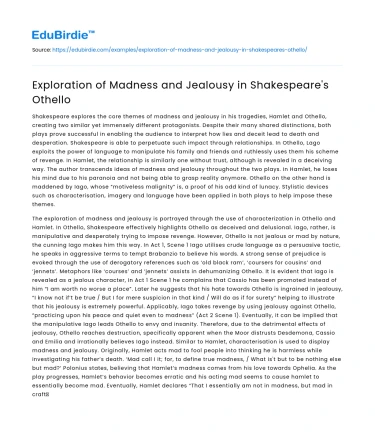Shakespeare explores the core themes of madness and jealousy in his tragedies, Hamlet and Othello, creating two similar yet immensely different protagonists. Despite their many shared distinctions, both plays prove successful in enabling the audience to interpret how lies and deceit lead to death and desperation. Shakespeare is able to perpetuate such impact through relationships. In Othello, Lago exploits the power of language to manipulate his family and friends and ruthlessly uses them his scheme of revenge. In Hamlet, the relationship is similarly one without trust, although is revealed in a deceiving way. The author transcends ideas of madness and jealousy throughout the two plays. In Hamlet, he loses his mind due to his paranoia and not being able to grasp reality anymore. Othello on the other hand is maddened by Iago, whose “motiveless malignity” is, a proof of his odd kind of lunacy. Stylistic devices such as characterisation, imagery and language have been applied in both plays to help impose these themes.
The exploration of madness and jealousy is portrayed through the use of characterization in Othello and Hamlet. In Othello, Shakespeare effectively highlights Othello as deceived and delusional. Iago, rather, is manipulative and desperately trying to impose revenge. However, Othello is not jealous or mad by nature, the cunning Iago makes him this way. In Act 1, Scene 1 Iago utilises crude language as a persuasive tactic, he speaks in aggressive terms to tempt Brabanzio to believe his words. A strong sense of prejudice is evoked through the use of derogatory references such as ‘old black ram’, ‘coursers for cousins’ and ‘jennets’. Metaphors like ‘courses’ and ‘jennets’ assists in dehumanizing Othello. It is evident that Iago is revealed as a jealous character, In Act 1 Scene 1 he complains that Cassio has been promoted instead of him “I am worth no worse a place”. Later he suggests that his hate towards Othello is ingrained in jealousy, “I know not if’t be true / But I for mere suspicion in that kind / Will do as if for surety” helping to illustrate that his jealousy is extremely powerful. Applicably, Iago takes revenge by using jealousy against Othello, “practicing upon his peace and quiet even to madness” (Act 2 Scene 1). Eventually, it can be implied that the manipulative Iago leads Othello to envy and insanity. Therefore, due to the detrimental effects of jealousy, Othello reaches destruction, specifically apparent when the Moor distrusts Desdemona, Cassio and Emilia and irrationally believes Iago instead. Similar to Hamlet, characterisation is used to display madness and jealousy. Originally, Hamlet acts mad to fool people into thinking he is harmless while investigating his father’s death. ‘Mad call I it; for, to define true madness, / What is't but to be nothing else but mad?’ Polonius states, believing that Hamlet’s madness comes from his love towards Ophelia. As the play progresses, Hamlet’s behavior becomes erratic and his acting mad seems to cause hamlet to essentially become mad. Eventually, Hamlet declares “That I essentially am not in madness, but mad in craft”. Nonetheless, his true madness resulted in his death as his seeking for revenge against the man who killed his father ended in damage of his family. Like Othello, the characters get what they want through lies and deceit. The Characterisation was successfully employed within both plays to deliver the theme to the audience.
Save your time!
We can take care of your essay
- Proper editing and formatting
- Free revision, title page, and bibliography
- Flexible prices and money-back guarantee
The imagery used to portray madness is varied in both plays. Unlike Iago’s uncouth language, Hamlet utilises imagery to efficiently persuade the audience that his anger and vengeance is truly allowed. This is because Hamlet’s revenge is mixed up with reality and not with manipulative lies. Shakespeare also utilises imagery to demonstrate Hamlet’s sadness as he feels his mother has betrayed ‘so excellent a king’. This imagery is important to emphasize betrayal, and by doing so the audience has an understanding of its significance. Nevertheless, Iago’s imagery is also successful in demonstrating how there is no true motive behind his quest for vengeance and has dehumanised himself, ‘Ere I would say, I would drown myself for the love of a guinea-hen, I would change my humanity with a baboon’ . Here he also argues that reason and intelligence are what separates humans from animals. Additionally, Hamlet is seen as mad, but his words contain more metaphysical meaning that those of Iago. The impression he generates through his language suggests that his intentions are focused. Unlike Iago’s futile animalistic imagery, Hamlet’s words tell a story, ‘you have my father much offended’. The personal pronoun ‘my’ emphasizes how he attempts to defend his anger. Consequently, Shakespeare has used the stylistic device of imagery to express betrayal and further madness.






 Stuck on your essay?
Stuck on your essay?

